 Armada (1880-1927): Velasco, Gravina, Infanta Isabel, Isabel II, Cristóbal Colón, Don Juan de Austria, Don Antonio de Ulloa, Conde del Venadito
Armada (1880-1927): Velasco, Gravina, Infanta Isabel, Isabel II, Cristóbal Colón, Don Juan de Austria, Don Antonio de Ulloa, Conde del Venadito
The Velasco class were eight unprotected cruisers built in the 1880s for the Armada (Spanish Navy) built in two different subclasses. The first batch composed of Velasco and Gravina were typical Vickers Armstrong style export unprotected cruisers. They were built by the Thames Ironworks & Shipbuilding & Engineering Co. Ltd. Leamouth, London. They differed from the rest by their fewer but heavier guns and were a bit faster (and were faster built) all the remainder six being built in Spain and much longer to complete, until 1889, and so being obsolete at the time. These single funnel iron hull, barque rigged vessels were not intended for defending the homeland but rather as station ships in the Spanish colonial Empire. When the war of 1898 broke out, they were both stationed in Cuba and the Philippines and were seen merely as gunboats. Three were sunk during the war, one was lost in a 1884 typhoon and another in 1895 and the remainder lingered until 1905-1927. Don Juan de Austria became the gunboat USS Don Juan de Austria after capture.
Development
In 1879, the Armada was mostly made of ageing sailing mixed frigates and nine elderly ironclads or armoured ships, the last dating back from 1870. The last of these corvettes and frigates was launched in 1869 and the whole decade of 1869-1879 saw no new naval plan or construction, leaving the Armada, especially concerning its colonial Empire, without serious assets for its protection. Thus in 1878 it was decided to order a dozen masted unprotected cruisers to provide a modern array of protective station ships. Armament and range were the priority, not speed. The first three were ordered in 1878 two three Spanish yard and 3289 tonne wooden built vessels, the Aragon class, initially built as ironclads. They mixed Krupp and Hontoria guns, were launched in 1879 and 1881.
However they were recoignised as of unequal construction quality and weakly protected, so it was decided quickly to also get the latest cruiser design from Britain.
The Velasco Class was thus designed as more modern iron-hulled ships, smaller, cheaper, and ordered in Britain as second-class unprotected cruisers. By the standards of the time however they were nothing more than large gunboats, designed for overseas colonial service, diplomatic representation, certainly not fleet actions or combating major naval powers of the time. The first pair was built at Blackwall yard, otherwise known as Thames Ironworks & Shipbuilding & Engineering Co. Ltd. in Leamouth under Spanish surpervision, as Velasco and Gravina. Both were launched in 1881, after the last two Aragon class vessels. It was understood that the remainder six would be built in Spain, with a different artillery set.
In essence, they were still well rigged, masted ships with a horizontal compound steam engine rated for 1500 hp.
The next Infanta Isabel, Isabel II, Cristóbal Colón, Don Juan de Austria, Don Antonio de Ulloa, Conde del Venadito were ordered to various Spanish yards, the first in Cadiz, the second in Ferrol, and the remainder at Carraca and Cartagena. Construction time was above four years, five in some cases, the last being completed in 1889. By 1890 they were already obsolete.
Design of the class

Model realized by British Thames Iron wks. Yard. Note the counterkeels and old style clipper stern and rudder. Officers had their accomodations in the poop.
The Velasco class differed into slightly different subclasses: Velasco and Gravina were built in Britain, by Thames Ironworks & Shipbuilding & Engineering Co. Ltd. in Leamouth, London. They had fewer gun that the others, but they were heavier. They had better machinery and were slightly faster as well. Those built at various shipyards in Spain took a longer time to complete. The first two British-built were completed in 1881, the last of the Spanish built in 1889, making them obsolete. They were caracterized by their fairly tall funnel, iron hull, barge rig. They however lacked any side armor.
The Velasco class were glorified gunboats intended for colonial service. They were small and cheap to operate, could deal with local insurgents and show the flag, but certainly not going toe to toe with foreign cruisers of the next generation. As a result, they stood little chance against the US Navy. The latter was inferior on paper only, but way ahead in terms of quality. Classes as “cruceros” (cruisers) they looked good on paper at the Royal Court back in Spain still. Two were lost at sea due to typhoons, three were sunk during the Spanish-American War in 1898. The three survivors lasted in the early 1900s and Infanta Isabel was the last to go, scrapped in 1927.
Hull and general design
The Velasco class cruisers were quite similar to export British unprotected cruisers made by Vickers. With just 1,150 t in displacement standard, they measured 64 meters between perpendiculars and at the waterline/overall 67.4 meters (210-215 ft) for a Beam of 9.4 to 9.8 meters (32-36 ft) and a 3,9 m Draft (13 ft 8 in) and 4.20 meters at max load, max draught. They were indeed small divergences between the two subclasses.
They of course had a sail plan, rigged as barques, with 1.132 m² surface total of velum sails.
Powerplant
This consisted in a Compound Horizontal steam engine, coupled with four cylindrical boilers. This powerplant was rated for 1500 hp for a max speed of 13 knots on trials. In reality by 1898 poor maintenance meant 10 knots at best was more likely. They carried just 220t of coal for local operation as their range was limited to Endurance, still 2500 nautical miles at 7 knots or 4,600 km.
Armament
Velasco and Gravina subclass:
Two 6-inch/26 (152 mm) Armstrong guns
Two 3-inch/12 (70 mm) Hontoria guns*
Two 25mm/40 Nordenfelt MGs machine guns*
Two 14-inch (356 mm) Whitehead torpedo tubes
Infanta Isabel subclass:
Four 120-millimetre (4.7 in) Hontoria guns
Four 37 mm/17 6-pounder Hotchkiss guns*
One Maxim machine gun or four 25mm/40 Nordenfelt MGs*
Two 14-inch (356 mm) Whitehead torpedo tubes.
*dismountable to be placed on a steam launch for landing parties)
Infanta Isabel as TS in 1921:
One 66 mm gun, ten 57 mm 6-pounder guns.
6-in (152.4mm/26) M1881 Armstrong guns
Likely Mark II type (1st gen). Called the BL 6-inch as they were breech loading guns. These two guns were NOT located on both the forecastle and stern upper deck due to stability concerns, but instead amidship, sponsoned on the lower deck. So they could only fire on one side and not cross deck at a rate of one per minute.
Specs:
Weight: 81 cwt or 89 cwt (4½ tons)
Shell: 100 pounds (45.36 kg), MV c1,800 fps (550 m/s)
Breech: 3 motion interrupted screw with De Bange obturation.
Maximum range: 10,000 yards (9,100 m)
120mm Hontoria guns
The Gonzalez Hontoria de 12 cm modello 1883 (4.7 in) used on these ships were posted amidship, sponsoned, one on each corber of the lower deck for extra stability.
José González Hontoria was a Spanish inventor and field marshal of marine infantry, brigadier of the navy which in the 1800s imported weapons from Krupp, Armstrong Whitworth and Schneider et Cie. Her studied them as well as explosives, metallurgy, and industrial production and developed his own company to manufacturing guns fused with the best ideas of all designs.
The 120 mm was one of the very first designs, from 1883, Produced from 1886.
They were critized however for being an outdated design, slow rate of fire and short barrel length resulting in lower range compared to British or Italian equivalents.
Specifications:
Mass: 2.6 t (2.9 short tons), Length 4.4 m (14 ft 5 in); barrel 4.2 m (13 ft 9 in) 35 caliber, Height 2.5 m (8 ft 2 in)
Shell: Separate 13 kg (29 lb) smokeless powder bagged charge. 24 kg (53 lb)
Muzzle velocity: 612 m/s (2,010 ft/s), max range 10 km (6.2 mi) at +25°
Breech: Interrupted screw.
3-inch/12 (70 mm) Hontoria guns
Interestingly they were called “Cañones de desembarco de 70 mm”. They were indeed posted on pivot mounts on the forecastle and poop, axially. But could be dismounted and placed on a wheeled undercarriage for landing parties. No data yet.
47 mm/17 (3-pounder/1.9 in) Hotchkiss guns
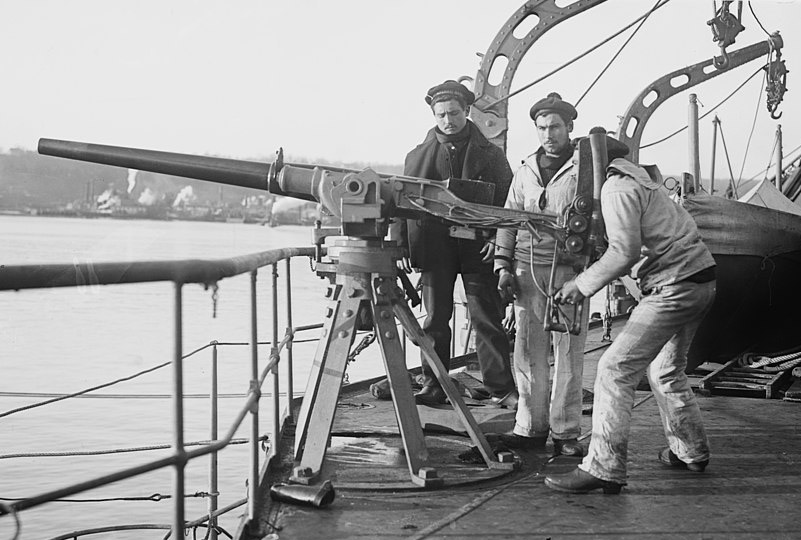
British sources says 57 mm (6 pdr). Classic among classics used by all navues of the time as quick firing artillery against torpedo boats. They were located on small sponsons on the forcastle and poop.
Specs:
Mass: 240 kg (530 lb), Length 2 m (6 ft 7 in), barrel 1.8 m (5 ft 11 in) 40 caliber
Shell: Fixed QF 47 × 376 mm R, 3 kg (6.6 lb) complete, 1.5 kg (3.3 lb) projectile
Breech: Vertical sliding-wedge, 30 rpm, mv 571 m/s (1,870 ft/s)
Max range 5.9 km (3.7 mi) at +20°
14-inch (356 mm) Whitehead torpedo tubes
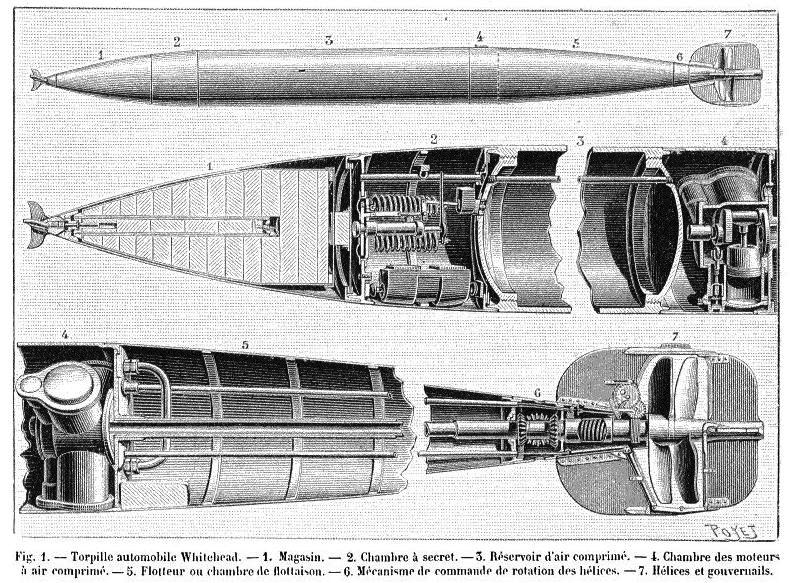
They were fixed in the broadside underwater for close range. Very early model, prior to the Mark I (1891). Still had the caracteristic spindle shape of the 1879 models, used virtualy by all navies of the time. This was the best seller made from 1868 onwards.
Specs:
Lenght 11 feet 7 inches (3.53 m), diameter of 14 inches (36 cm).
Weight 346 pounds (157 kg), 40-pound (18 kg) guncotton warhead.
8 knots (15 km/h; 9.2 mph), range of 200 yards (180 m).
Protection
None, as specified above. Wrough Iron all across the ship, and wooden backing plus wooden deck. There was some compartimentation underwater still for a reasonable protection in case of flooding.
As a side notes, these ships were among the first iron-hulled ships built in Spain, and had electric light projectors, that came in handy during the bombardment of Melilla during the Rif War.
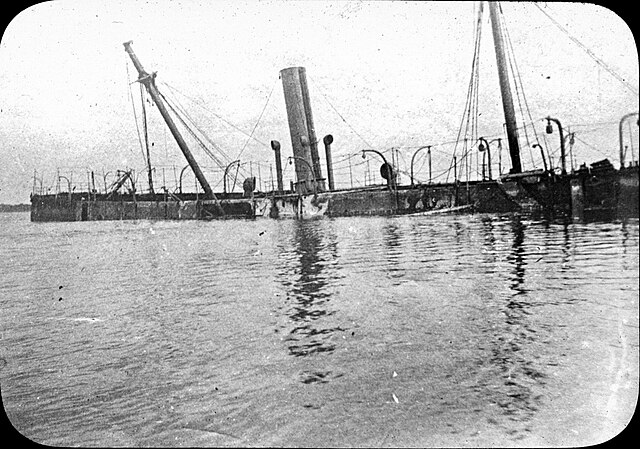
The wreck of Velasco in 1898

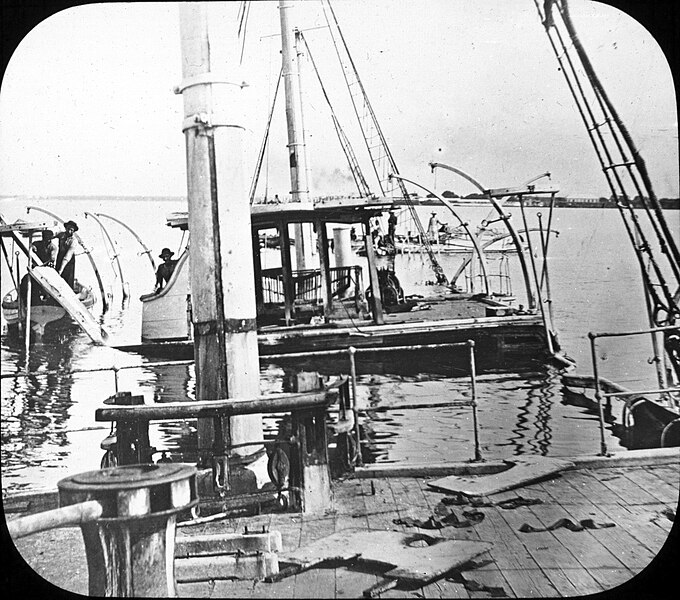
The wreck of Don Antonio de Ulloa
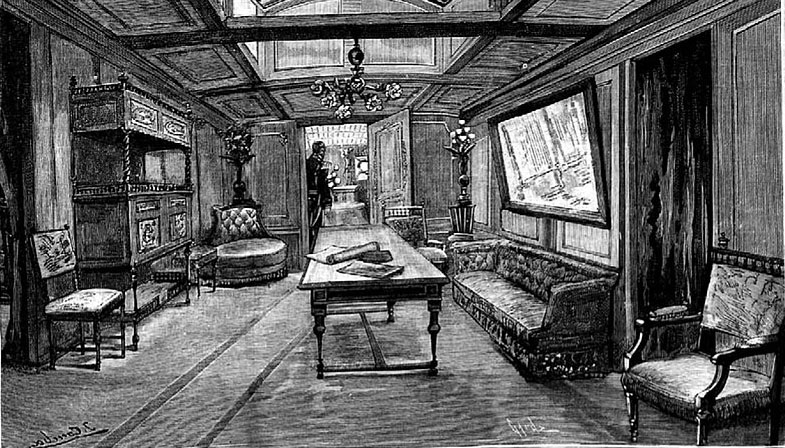
Count of Venadito as a Royal Yacht, Queen Cristina’s quarters
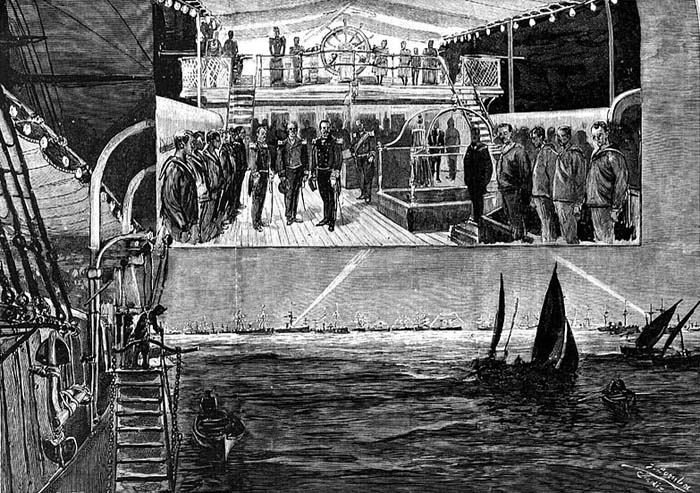
Commemorative engraving of the Conde de Venadito in 1892
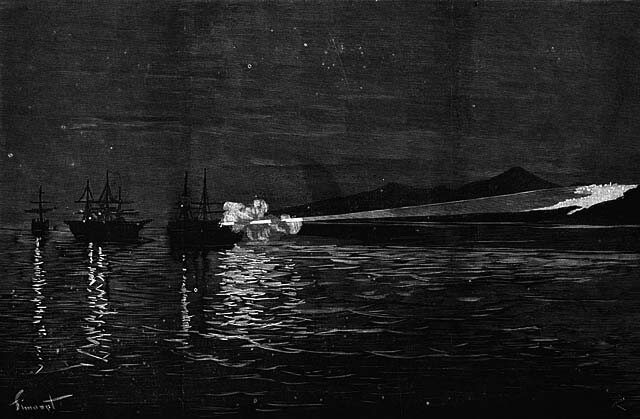
The Count of Venadito illuminating the Riffian coast during the Margallo War (December 1893)
⚙ specifications |
|
| Displacement | 1,152 tons |
| Dimensions | 210 x 32 x 13 ft 8 in (64 x 9.8 x 4.17 m) |
| Propulsion | & barque-rigged |
| Speed | 13 knots (24 km/h) |
| Range | 200 to 220 tons of coal |
| Armament (Velasco class) | 2× 6-in, 2× 3-in, 2 MG, 2× 14-in TTs |
| Armament* | 4× 4.7 in, 4× 6-pdr, 1 MG, 2× 14-in TTs |
| Crew | 173* |
*Infanta Isabel 1921: 1× 66 mm, 10× 6-pdr, crew 194.
 Velasco
Velasco
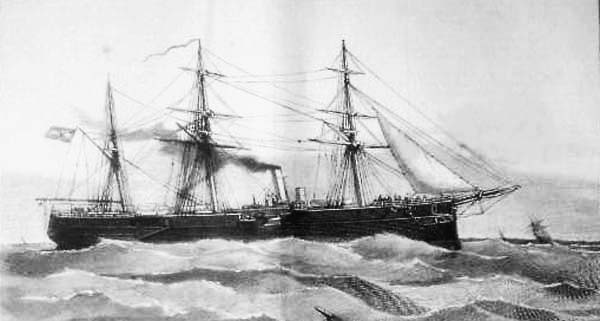
Velasco arrived in the Philippines in 1882 and manoeuvered with sisters Gravina as well as the larger protected cruiser Aragón in a retaliation operation against the islands of the Joló archipelago in revolt. By August 1896, she had to deal with the Tagalog insurrection in the Philippines. On the 30th she was attacked by the insurgents. She took part in a landing, sending her own party to restore order in San Roque and Manila. On February 14, 1897, she shelled the island of Nay, against insurgent trenches at Bacoor, Vinacayan, Cavite Viejo and Noveleta. On May 1, 1898, when the US fleet arrived, she was found without her artillery in overhaul, anchored with the gunboat General Lezo in the Cavite Arsenal. She did not took part in the Battle of Cavite and was apparently scuttled to avoid capture.
 Gravina
Gravina
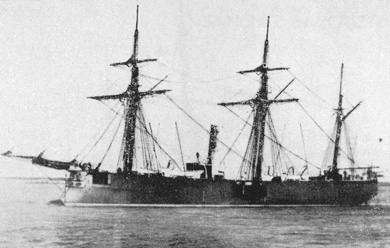
Coll. Don Alfredo Aguilera coll. via todoavante.es
Gravina was named in honor of Federico Gravina, a Spanish soldier and sailor. Second built at Blackwall, laid down in 1881. She had a short service: Assignd to the Pacific squadron and base din Manilla, Philippines, she she sank after hitting a shoal during a typhoon north of Luzon, in the waters of Fuga Island. It happened on July 10, 1884 while en route to Shanghai, and lost two officers and seven crewmen. She was declared a total constructive loss and left there.
 Infanta Isabel
Infanta Isabel
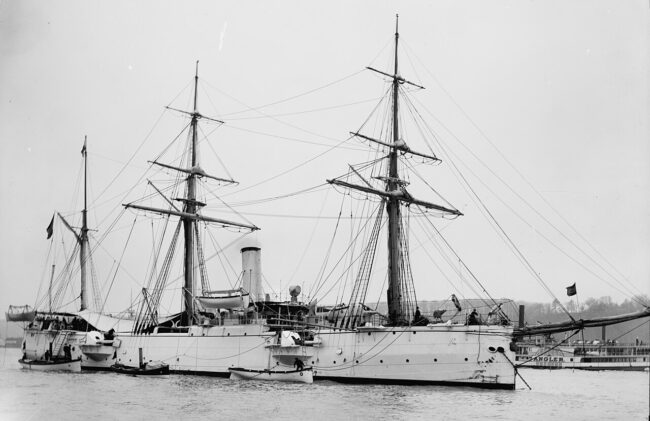
Infanta Isabel was the first metal-hulled cruiser built in Spain. In 1895, with the Count of Venadito, she tried to rescue the Christ. Colombo. She was assigned in 1887 to the Río de la Plata Naval Station under command of Joaquín Lazaga. On July 10 she rescued 27 Argentines from disastrous floods. Three years later in 1890 (captain Ramón Auñónà) she led an international division made up of British, American and Uruguayan ships to mediate between the Argentine and insurgents of the “Parque Revolution”.
On October 12, 1892 she took part in a Parade held in New York (4th Centenary of the Discovery of America) under Captain D. Julián García de la Vega.
The Spanish-American War saw her idle in Havana Harbor, being repaired. She took no part in the fight and after the Treaty of Paris was signed, article V stated that uncaptured warships were to be the property of Spain. So she was returned to Spain with Count of Venadito.
In 1900, May 18 she was to be part of 25 units decommissioned as ineffective. For her it was decided that:
The Infanta Isabel, also without any military value, is suitable for the service of the Canary Islands, the Gold Coast and possessions of Guinea, and its conservation, as long as there is no other military efficiency, seems unavoidable. […] Art. 2. Of the remaining ships, the Numancia, the Vitoria and the Infanta Isabel will be decommissioned when they require the change of their current boilers or other important repairs or hulls.
She thus remained active but stripped of her torpedo tubes, reclassified as gunboat. By 1902 she was in the Canary Islands with the torpedo boats Ariete, Azor and Rayo. On April 8, 1907 she was in Cartagena for an official visit of the of King Edward VII. She was modernized between 1910 and 1911, eliminating ehr artillery, replaced by two 70 mm Skoda guns and then 57 mm Nordenfelt guns.
During WWI she patrolled the Gulf of Guinea, and coast of Morocco until final discharge in 1926, after 39 years of service…
 Isabel II
Isabel II
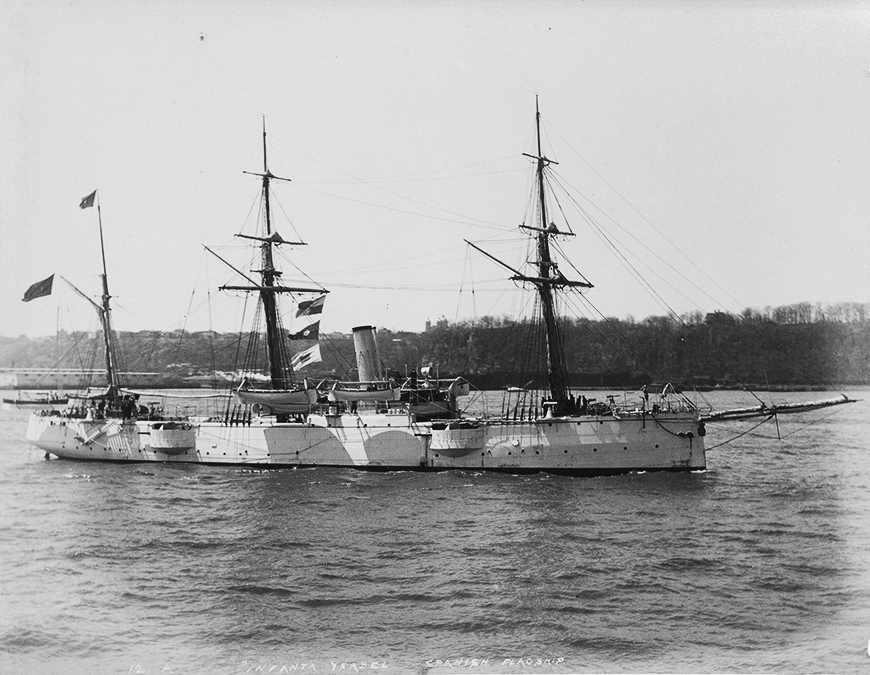
War of 1898: On June 12, 1898, Isabel II was sent to deal with the auxiliary cruiser USS Saint Paul blockading the port of San Juan in Puerto Rico, and sortied with the destroyer Terror and cover her to the optimal distance for torpedo attack. Terror suffered a direct hit and leaked, forced to retreat undercover of Isabel II.
On June 28, Isabel II protected the steamship Antonio López from Cádiz, stranded on Playa Socorro by the auxiliary cruiser USS Yosemite. She was captured as the protected cruiser USS New Orleans appeared. After the war, the Treaty of Paris specified she would be returned to Spain. Her machines however were in such poor condition that by 1900, May 18 decree she was considered ineffective. She was to be decommissoned although some argued to preserve her and Conde de Venadito. Or replace their boilers but the cost was estimated at 500,000 pesetas, including her reconstruction, 60,000 pesetas for each ship plus conservation in order to act as anti-insurgent vessel whereas smaller tonnage vessels were seen as more useful. These plans were dropped.
She was decommissioned on January 3, 1901. From 1902 she became a pontoon in Cartagena, part of its anti-submarine defenses, until 1935.
 Cristóbal Colón
Cristóbal Colón
Shortly after entering service, she was assigned to the royal escort in Cantabrian waters (Court’s summer vacation in San Sebastián) with a Destroyer and gunboat Mac-Mahón. In 1890 she she took mart in manoeuvers off Cádiz, acting as “enemy” ship, targeted by the Peral submarine. In 1894, she transferred the new Extraordinary Envoy and Plenipotentiary Minister of Spain in Morocco, Emilio de Ojeda y Perpignan. She sailed to land him in Tangier and used her guns as diplomatic leverage. After relieving her twin Infanta Isabel as station ship in the Río de la Plata she took action during the insurrection in Cuba, and was posted in Havana station, where she sank in one of her patrols, runnind aground in the Los Colorados shoal, near Mantua Pinar del Río, on September 29, 1895 (no loss). Her hull broke in two after an October 1 hurricane.
 Don Juan de Austria
Don Juan de Austria
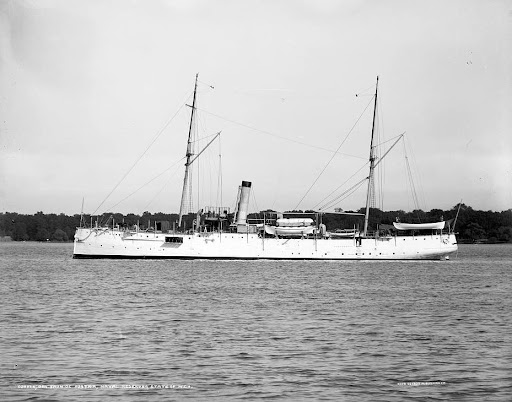
In 1890 Don Juan de Austria was assigned to the Philippine Islands with Don Antonio de Ulloa and Castilla. On April 9, 1890, they left Barcelona for the Philippines under command of captain Manuel de la Cámara y Livermore. They arrived in Manila on June 17. They were soon nicknamed the “black squadron” due to their hulls unlike the regulatory white used for colonial ships. She was sunk during the Battle of Cavite after receiving 13 hits, but was refloated later by the new occupiers, incorporated into the US fleet as gunboat under the name “USS Don Juan de Austria (photo as repainted in US srvice)”. She served in Canton, China, Hong Kong, visited Japan in 1902, but mostly was busy with “pacification duties” in the Philippines until April 1903.
In 1907 she was assigned to the Michigan Naval Militia, Detroit. She was recommissioned on April 6, 1917, patrolled New England and escorted Army tugs towing barges to Bermuda, escorted French and American submarines to Newport, and troopships carrying the US 26th Division from Europe, decommissioned at Portsmouth on 18 June 1919, BU.
 Don Antonio de Ulloa
Don Antonio de Ulloa
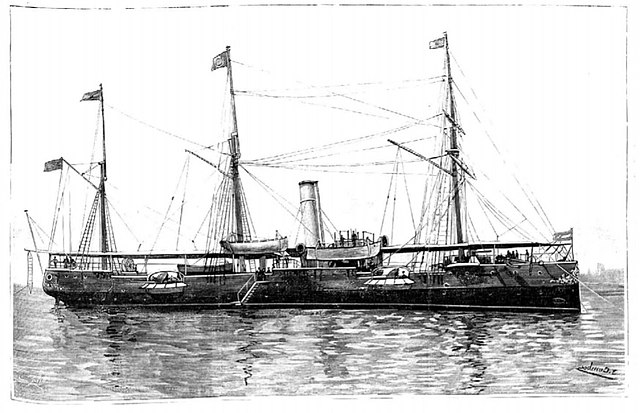
Name in honor of Antonio de Ulloa, writer, naturalist and military man she was sent to the Caroline Islands during the crisis between Spain and the German Empire. From 1890 she was assigned to the Philippine Islands as replacement for Gravina, lost in a typhoon. She served with the cruisers Castilla and Don Juan, leaving Barcelona on April 10, 1890, and nicknamed the “black squadron”. By April 1891, she became flagship, captain general, Philippine Station. She foufgh insurgents on Mindanao and restored ordered there.
Don Antonio de Ulloa went on against Filipino insurgents in 1896-1897, transported and supported landing forces notably to Zamboanga in 1897.
When war was declared and at the battle of Cavite she had two main guns removed to reinforce the the batteries at El Fraile and Corregidor. Her worn out machinery made her unable to sail. So she remained stationary with half crew, an easy target during the battle, with 33 direct hits (four 203 mm, three 152 mm one 127 mm and 47/37 mm). Captain José de Iturralde, was killed in action, officers all wounded, half her crew wounded or killed. Her wreck was refloated postwar and and sold for scrap.
 Conde del Venadito
Conde del Venadito
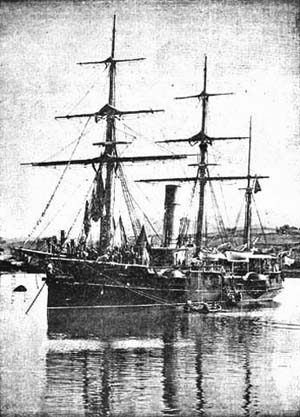 The Count of Venadito was transformed into a royal yacht in the Carraca arsenal in 1892, used by the queen regent and her children, for a cruise from Cádiz to Huelva for commemorations and a naval review dedicated to the memory of Christopher Columbus and IV Centenary of the Discovery of America.
The Count of Venadito was transformed into a royal yacht in the Carraca arsenal in 1892, used by the queen regent and her children, for a cruise from Cádiz to Huelva for commemorations and a naval review dedicated to the memory of Christopher Columbus and IV Centenary of the Discovery of America.
Moroccan War (1893):
In February 1893 she towed Isabel II, from Dakar and later joined the Training Squadron, deployed to Melilla on October 12 after incidents with Riffian forces. On October 21 (captain Emilio Díaz Moreu) she opened fire on Riffian positions. The next day she took part in the defense of the square, with cannons, and electric searchlights by night, devastating the enemy camp and providing signalmen for communication after telegraph cables were cut out. She was not alone, with the cruisers Alfonso XII, Isla de Cuba and Isla de Luzon.
Cuba and the war of 1898
She was posted to Cuba shortly after. By March 1895, Count of Venadito chased the Columbian Steamship Line Alliance on high seas (supplyigd the rebels). The ship would succeed a second time to land its supplies and weapons a week later. She tried to rescue her sister Christ. Colon. On May 14, 1898, the US blockading squadron was reduced to two cruisers and four auxiliary gunboats so she was ordered to foirce passage with the torpedo gunboat Nueva España. She was 13 km from the port, firing at a US ships that withdrew. At night however they were back port. The next day they faced ten ships and did not sortied again.
On June 10, 1898, nine ships blockaded the port of Havana, when the local Spanish force (Conde de Venadito, TB Nueva España, Vicente Yáñez Pinzón, gunboat Flecha) under Captain José Marenco y Gualter. They sortied not intended to get rhtrough but rather to lure out their pursuers within range of shore batteries. Bu it failed as blockading vessels kept their formations and fired at long range. Pinzón was the only hit.
Infanta Isabel transferring from Havana to Cádiz the remains of Captain Joaquín Bustamante y Quevedo and of Cr. Columbus. Postwar, the Treaty of Paris was signed, and she was returned to Spain.
By April 23, 1899, she was ordered by the captain general of Ferrol to set sail and help the wrecked steamship Zurbarán. In 1900 by Decree it was studied to preserving and modernize her, but it was denied for cost reasons. This she was decommissioned on 18 July 1902, and became a pontoon in Ferrol, munitions depot and part of anti-submarine defenses. She was sunk as naval target in early 1936, by Battleship Jaime I and the cruisers Libertad, Almirante Cervera and Miguel de Cervantes.
Read More/Src
Books
La Gaceta de Madrid, Número 139 Boletín Ordinario, publicado el sábado, 19 de mayo del 1900.
La Gaceta de Madrid, Número 4 Boletín Ordinario, el viernes, 4 de enero del 1901.
REVISTA DE HISTORIA NAVAL Número 150, pp. 33-48 ISSN: 012-467-X
Llorente, Juan Carlos; Luis Serrano y J.C. Llorente (2005).
McSherry, Patrick. «Cruiser Don Juan de Austria». Spanish American War Centennial Website.
Albert, Nofi (1996). The Spanish-American War, 1898. Conshohocken, Pennsylvania: Combined Books, Inc.
Chesneau, Roger; Eugene M. Kolesnik (1979). Conway’s All The World’s Fighting Ships 1860-1905
Coello Lillo, Juan Luis; Agustín Ramón Rodríguez González (2001). Buques de la Armada Española a través de la Fotografía.
Links
navypedia.org/
vidamaritima.com/ el-brigadier-gonzalez-hontoria
sci.military.naval.narkive.com/ naval-ordnance-info
1898.mforos.com los-canones-hontoria/
laststandonzombieisland.com hontoria-gun/
elgrancapitan.org
todoavante.es/ Gravina_(1882)
todoavante.es/ Infanta_Isabel_(1887)
todoavante.es/ Antonio_de_Ulloa_(1887)
todoavante.es Isabel_II_(1887)
todoavante.es Colon_(1889)
todoavante.es Juan_de_Austria_(1887)
spanamwar.com Donjuanaustria.htm
alojados.revistanaval.com
hemerotecadigital.bne.es/
web.archive.org history.navy.mil/ d-austr.htm
web.archive.org history.navy.mil/ c-colon.htm
books.google.es/
armada.defensa.gob.es pdf
vidamaritima.com la-perdida-del-crucero-cristobal-colon/
catalogacionarmas.com/ retrocarga-marina-1879-95.pdf
vidamaritima.com/ joaquin-maria-lazaga-y-el-crucero-infanta-isabel/
web.archive.org/ cervantesvirtual.com/
es.wikipedia.org/wiki/Clase_Velasco
commons.wikimedia.org Velasco_class_cruiser


 Latest Facebook Entry -
Latest Facebook Entry -  X(Tweeter) Naval Encyclopedia's deck archive
X(Tweeter) Naval Encyclopedia's deck archive Instagram (@navalencyc)
Instagram (@navalencyc)





 French Navy
French Navy Royal Navy
Royal Navy Russian Navy
Russian Navy Armada Espanola
Armada Espanola Austrian Navy
Austrian Navy K.u.K. Kriegsmarine
K.u.K. Kriegsmarine Dansk Marine
Dansk Marine Nautiko Hellenon
Nautiko Hellenon Koninklije Marine 1870
Koninklije Marine 1870 Marinha do Brasil
Marinha do Brasil Osmanlı Donanması
Osmanlı Donanması Marina Do Peru
Marina Do Peru Marinha do Portugal
Marinha do Portugal Regia Marina 1870
Regia Marina 1870 Nihhon Kaigun 1870
Nihhon Kaigun 1870 Preußische Marine 1870
Preußische Marine 1870 Russkiy Flot 1870
Russkiy Flot 1870 Svenska marinen
Svenska marinen Søværnet
Søværnet Union Navy
Union Navy Confederate Navy
Confederate Navy Armada de Argentina
Armada de Argentina Imperial Chinese Navy
Imperial Chinese Navy Marinha do Portugal
Marinha do Portugal Mexico
Mexico Kaiserliche Marine
Kaiserliche Marine 1898 US Navy
1898 US Navy Sovietskiy Flot
Sovietskiy Flot Royal Canadian Navy
Royal Canadian Navy Royal Australian Navy
Royal Australian Navy RNZN Fleet
RNZN Fleet Chinese Navy 1937
Chinese Navy 1937 Kriegsmarine
Kriegsmarine Chilean Navy
Chilean Navy Danish Navy
Danish Navy Finnish Navy
Finnish Navy Hellenic Navy
Hellenic Navy Polish Navy
Polish Navy Romanian Navy
Romanian Navy Turkish Navy
Turkish Navy Royal Yugoslav Navy
Royal Yugoslav Navy Royal Thai Navy
Royal Thai Navy Minor Navies
Minor Navies Albania
Albania Austria
Austria Belgium
Belgium Columbia
Columbia Costa Rica
Costa Rica Cuba
Cuba Czechoslovakia
Czechoslovakia Dominican Republic
Dominican Republic Haiti
Haiti Hungary
Hungary Honduras
Honduras Estonia
Estonia Iceland
Iceland Eire
Eire Equador
Equador Iran
Iran Iraq
Iraq Latvia
Latvia Liberia
Liberia Lithuania
Lithuania Mandchukuo
Mandchukuo Morocco
Morocco Nicaragua
Nicaragua Persia
Persia San Salvador
San Salvador Sarawak
Sarawak Uruguay
Uruguay Venezuela
Venezuela Zanzibar
Zanzibar Warsaw Pact Navies
Warsaw Pact Navies Bulgaria
Bulgaria Hungary
Hungary

 Bundesmarine
Bundesmarine Dutch Navy
Dutch Navy Hellenic Navy
Hellenic Navy Marina Militare
Marina Militare Yugoslav Navy
Yugoslav Navy Chinese Navy
Chinese Navy Indian Navy
Indian Navy Indonesian Navy
Indonesian Navy JMSDF
JMSDF North Korean Navy
North Korean Navy Pakistani Navy
Pakistani Navy Philippines Navy
Philippines Navy ROKN
ROKN Rep. of Singapore Navy
Rep. of Singapore Navy Taiwanese Navy
Taiwanese Navy IDF Navy
IDF Navy Saudi Navy
Saudi Navy Royal New Zealand Navy
Royal New Zealand Navy Egyptian Navy
Egyptian Navy South African Navy
South African Navy






























 Ukrainian Navy
Ukrainian Navy dbodesign
dbodesign